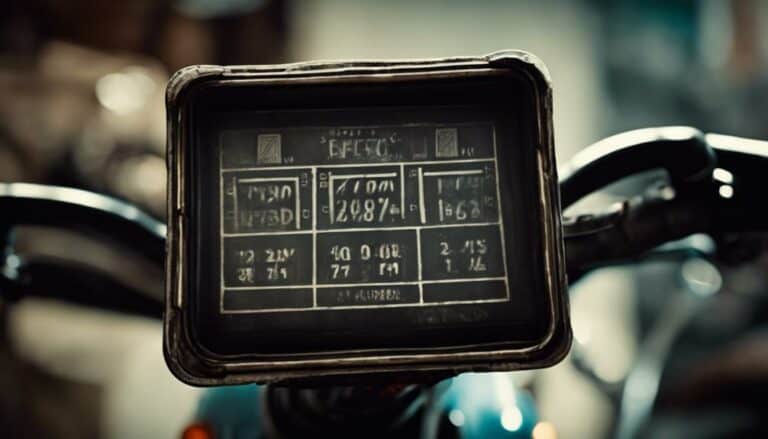You might think decoding Harley Davidson trouble codes is complex, but with the right guidance, it can be a straightforward process. Understanding the intricacies of your Harley's diagnostic system is crucial for maintaining its peak performance.
By grasping the fundamentals of interpreting check engine light signals and navigating code categories, you'll be equipped to handle potential issues effectively.
Stay tuned to discover how these skills can empower you to troubleshoot problems and keep your Harley running smoothly.
Key Takeaways
- Use odometer reset button to access and interpret trouble codes.
- Identify code meanings through menu navigation for issue resolution.
- Prioritize troubleshooting efforts based on code categories (current, historic, pending).
- Clear codes post resolution to maintain optimal performance.
Understanding Harley-Davidson Trouble Codes
To understand Harley-Davidson Trouble Codes effectively, you must grasp the specific process utilizing the odometer reset button. When a check engine light appears, you can access trouble codes by cycling the ignition switch on and off three times, then pressing the odometer reset button. The codes will be displayed on the odometer, indicating if they're current, historic, or pending. These codes consist of letters that correspond to specific issues within different modules of the motorcycle. By navigating the selection menu using the odometer reset button, you can identify the meaning of each letter, aiding in diagnostics.
When it comes to clearing codes, it's crucial to follow the correct steps to ensure that only resolved issues are removed. Thoroughly completing the diagnostic process for each module is essential for comprehensive troubleshooting of the Harley-Davidson system. Understanding how to navigate the selection menu and interpret the codes is key to effectively addressing any problems that may arise.
Interpreting Check Engine Light Signals
When the check engine light illuminates on your Harley-Davidson, it signals potential system issues or faults that can be interpreted through the use of Diagnostic Trouble Codes (DTCs). These codes are essential for understanding the specific problem affecting your motorcycle.
By pressing and holding the odometer reset button, you can access these DTCs and interpret them to diagnose the issue accurately. The check engine light serves as a warning that something is amiss within the various modules of your Harley-Davidson, such as the ignition module.
Each DTC corresponds to a particular fault within the system, aiding in the troubleshooting process. Learning to interpret these codes empowers you to address engine problems effectively, ensuring your Harley-Davidson runs smoothly.
Familiarizing yourself with the diagnostic system and the interpretation of DTCs is crucial for maintaining and repairing your motorcycle, allowing you to address issues promptly and accurately.
Navigating Harley Davidson Code Categories
When interpreting Harley Davidson trouble codes, understanding their categorization into current, historic, and pending codes is crucial for effective diagnostics. Current codes represent ongoing issues that need immediate attention, while historic codes indicate past problems that might still impact the motorcycle's performance. Pending codes require multiple occurrences to set, signaling potential issues that are developing.
By navigating through these code categories, you can prioritize troubleshooting efforts and address specific problems efficiently. Clearing current codes after resolving the underlying problems is essential to ensure optimal motorcycle performance. Being able to distinguish between current, historic, and pending codes enables you to focus on resolving existing issues and preventing future complications.
This structured approach to interpreting trouble codes helps in identifying the root cause of problems and maintaining the health of your Harley Davidson motorcycle.
Accessing and Decoding Trouble Codes
Access the diagnostic trouble codes on your Harley Davidson by following these steps:
- Turn Off and On: Start by turning the ignition switch off, then turn the Run/Stop switch to Run.
- Push and Hold: Push and hold the odometer reset button while turning the ignition switch to Ignition.
- Navigate through Menu: Release the odometer reset button and push it again to access the selection menu, where you can choose different diagnostics modules by interpreting the letters displayed.
Applying Troubleshooting Skills in Maintenance
To effectively maintain your Harley-Davidson motorcycle, mastering troubleshooting skills is essential for accurately identifying and resolving issues within its electronic systems. Understanding diagnostic trouble codes (DTCs) is crucial as they help pinpoint specific problem areas.
By applying systematic procedures, you can efficiently address maintenance tasks and ensure effective solutions. After resolving issues, clearing DTCs is vital to monitor whether the problem has been successfully dealt with. Utilizing diagnostic tools can enhance your troubleshooting capabilities, making maintenance of Harley-Davidson motorcycles more manageable.
By reading and interpreting DTCs, you can efficiently navigate the electronic systems of your bike and address any underlying issues promptly. Remember to follow a structured approach when troubleshooting, as this will lead to more effective maintenance practices and a smoother running Harley-Davidson.
Stay proactive in monitoring and addressing DTCs to keep your motorcycle in top condition.
Conclusion
Now that you have mastered the art of reading Harley Davidson trouble codes, you can confidently diagnose and resolve any issues that may arise with your motorcycle.
For example, imagine cruising down the open road when suddenly your check engine light appears. By following the steps outlined in this guide, you can quickly identify the problem, clear the code, and get back to enjoying your ride without missing a beat.

